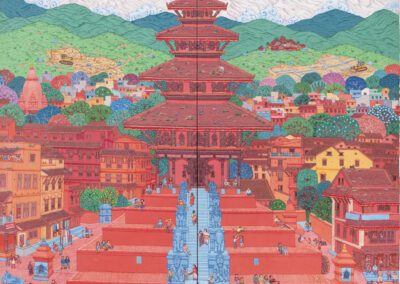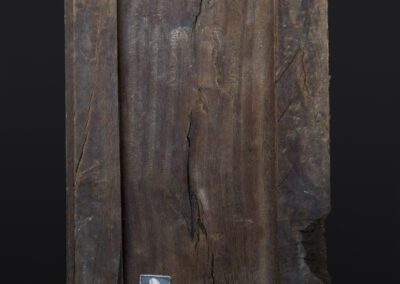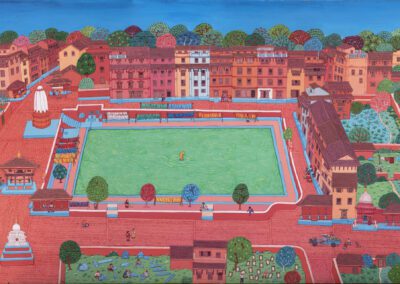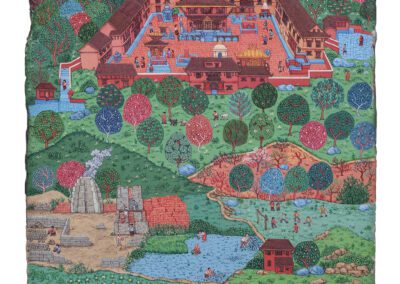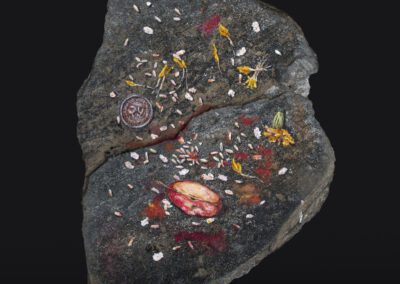Hitesh Vaidya, the Mittal Institute’s newest Visiting Artist Fellow, is a visual artist and cultural practitioner based in Bhaktapur, Nepal. The Visiting Artist Fellowship (VAF) is a research-centered experience for mid-career artists from South Asia. Artists spend eight weeks on campus, using the vast resources of Harvard’s intellectual community to enhance their artistic practice.
Vaidya’s practice explores how everyday objects, spaces, and rituals quietly shape collective memory, bridging traditional culture with contemporary life. Drawing on the lived histories of Bhaktapur, Kathmandu, and Patan, Vaidya interprets the city through its domestic rhythms, communal architectures, and interpersonal relationships. We spoke with him about his work and what he hopes to explore during his fellowship.
Save the date to join Vaidya at the Visiting Artist Fellows Art Exhibition Launch on October 21, where he will participate in a panel discussion with Jinah Kim, George P. Bickford Professor of Indian and South Asian Art in the Department of History of Art & Architecture and Faculty Director of the Arts Advisory Council, Mittal Institute, Harvard University.
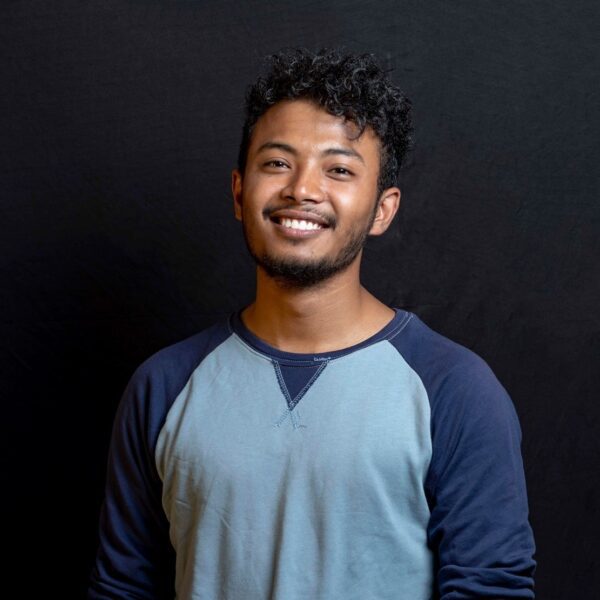
Hitesh Vaidya
Mittal Institute: Welcome, Hitesh! Can you give us a background on yourself?
Hitesh Vaidya: Thank you. It is an honor to be selected as a visiting artist fellow for the Mittal Institute. I am a visual artist based in Bhaktapur, Nepal. I earned my bachelor’s degree in fine arts from Kathmandu University, Department of Arts, in 2019. Through painterly interventions into existing objects, communal interventions, and curatorial projects, my work questions the idea of where we belong and what belongs to us. I also run an art studio, which I am expanding as a community-driven art space in Bhaktapur with my friend, artist Pooja Duwal.
I was a participant artist in Kathmandu Triennale 2022 as well as the coordinator for Nepal Art Council, one of the biggest venues of the Triennale. I also recently participated at India Art Fair 2024.
Mittal Institute: Can you describe your artistic motivations?
Hitesh Vaidya: I believe that human experiences are encapsulated in the things we use and the spaces we live in. It works as a reference in the process of remembrance, can evoke emotion, and aid in identity formation for individuals, families, and communities. I interpret the city through everyday objects, daily rituals, and interpersonal relationships within its communal spaces. I embrace traditional art forms and repurpose local materials from the city’s vernacular architecture to investigate contemporary experiences of the city. My practices as a medium include painting to painterly intervention into existing objects and working among still and moving images.
I believe that human experiences are encapsulated in the things we use and the spaces we live in.
I see my role as a cultural practitioner in bridging artistic practice with communal histories and memories – I seek to create spaces locally where people across different spheres and disciplines can come together to rethink notions of shared space, culture, and community. Thus, I see communal artistic interventions and public engagements as an intrinsic part of my artistic practice.
Mittal Institute: What most excites you about being in Cambridge and on the Harvard campus?
Hitesh Vaidya: As one of the most respected educational institutions in the world, I am excited to learn about contemporary artistic practice through insightful lectures, conversations, and critical feedback from the professors and diverse students here at Harvard. Cambridge is known for its rich art and museum spaces, which I am confident will be a valuable learning space for me to incorporate into my own context as well. As the resources for contemporary art practice are limited in Nepal, I am excited to gain a broader perspective about my own art practice and communal art space through the museums, library resources, curatorial practices, and programming here.
Moreover, I am excited to share insights about native knowledge systems, ritual practices, and communal values from my context with the varied diaspora here at Harvard.
I am excited to share insights about native knowledge systems, ritual practices, and communal values from my context with the varied diaspora here at Harvard.
Mittal Institute: While at Harvard this fall, you are researching models for community-rooted contemporary art spaces in Bhaktapur. Can you expand on this research project and what you hope to explore?
Hitesh Vaidya: I hope to create a sustainable community-based contemporary art space in Bhaktapur that creates a symbiotic relationship between diverse artists and researchers with the local community. I have been building a network of various artists, researchers, and cultural practitioners in Bhaktapur to create multi-disciplinary artistic programmes. From the artists, practitioners, and spaces at Harvard, I hope to build collaborative networks and learn models to suitably adopt in Nepal. Through this, we hope to build strong interdependent models of art spaces that value local knowledge, heritage, lived experiences, and collective aspirations.
Furthermore, I would love to share efforts by various artists, researchers and art practitioners in Nepal, and possibly bridge meaningful collaborations and discussions with peers and mentors here.
Hitesh Vaidya’s work is on display at the Mittal Institute through November 21, 2025.

